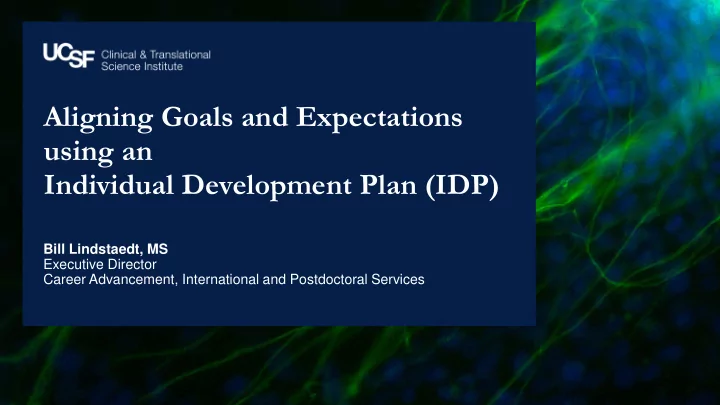

Aligning Goals and Expectations using an Individual Development Plan (IDP) Bill Lindstaedt, MS Executive Director Career Advancement, International and Postdoctoral Services
What will we cover in this session? Why you and your mentee should use an IDP IDP’s from your mentee’s perspective What is an IDP? What should a completed IDP look like? IDP process from the mentor’s perspective: Using an IDP to structure your mentoring conversations Using an IDP to motivate your mentee Using the IDP process for accountability 2
What will we cover in this session? Why you and your mentee should use an IDP IDP’s from your mentee’s perspective What is an IDP? What should a completed IDP look like? IDP process from the mentor’s perspective: Using an IDP to structure your mentoring conversations Using an IDP to motivate your mentee Using the IDP process for accountability 3
Why you and your mentee should use an IDP Funders may require or encourage the use of IDP’s 4
What will we cover in this session? Why you and your mentee should use an IDP IDP’s from your mentee’s perspective What is an IDP? What should a completed IDP look like? IDP process from the mentor’s perspective: Using an IDP to structure your mentoring conversations Using an IDP to motivate your mentee Using the IDP process for accountability 5
What is an IDP? IDP is a Process Purposeful goal setting activity by the mentee Capped by supportive constructive feedback session with mentor Iterative, repetitive process 6
IDP is a Process – Four steps include 1. Assessment – looking back and taking stock What have I accomplished? Assessing my skills, values, interests 2. Career exploration What is my post-training career goal? 3. Goal setting What will I accomplish in the next year? • To finish my training stage • To reach my post-training career goal? 4. Mentor and Mentee – Implementation How will I engage my mentors to help me accomplish all that I must do? 7
IDP is a Process – Four steps include 1. Assessment – looking back and taking stock What have I accomplished? Mentee alone Assessing my skills, values, interests 2. Career exploration What is my post-training career goal? 3. Goal setting What will I accomplish in the next year? • To finish my training stage • To reach my post-training career goal? 4. Mentor and Mentee – Implementation How will I engage my mentors to help me accomplish all that I must do? 8
What is an IDP? IDP is also a Product Written document Answers two critical areas of career planning • Big picture plan: Where am I headed with my career? On the right track? • Annual plan: How will I get there? How will I continue to succeed? 9
What does a completed IDP “product” include? Taking stock : Looking backward – What have I accomplished? How have I improved? Current assessment – What are my skills? What engages me? What rewards or outcomes (values) do I need from my work? Looking forward : Plan A/Plan B: Career goals A written list of (annual) goals mapped onto a timeline Annual goals should be in service of your mentee’s Plan A and B career goals 10
1. Basic sciences PhD trainee model, using the myIDP tool 11 1/12/2 Presentation Title and/or Sub Brand Name
2. Clinical fellow model, using UCSF Peds’ portfolio tool 12 1/12/2
3. Mentee/Mentor model, from Angela DePace’s research group at Harvard 13
Try starting your own IDP Step 1: Start with Self Assessment Skills Assessment: Are there tasks where you excel? Where do you want to improve? Values Assessment: What rewards or outcomes are most important? What work conditions would you prioritize? 14
Why is assessment important – skills, interests, values? Career Skills Satisfaction Interests Values 15
Values Clarification Discussion Values Skills Fit! Interests Share with your partner: -Introductions -What is one value that you ranked as most important? -What is one challenge you will face in your current role, due to the fact that you hold that value most important? -What is one potential solution to that challenge? -Partner: What is ANOTHER potential solution to that challenge? -3 minutes per partner 16
Values Clarification Discussion Values Skills Fit! Interests/ Lessons: Passions -No career option is perfect -There will be values-related challenges to every career option -There will be skills challenges to every career option -Plan to deal with challenges, or change careers -Colleagues and mentors can help you solve challenges 17
Let’s begin an IDP Step 2: Think and write responses to the first four prompts on the IDP form 18
Let’s begin an IDP Step 2: Think and write responses to the first four prompts on the IDP form Discuss IDP writing experience with partner 19
What will we cover in this session? Why you and your mentee should use an IDP IDP’s from your mentee’s perspective What is an IDP? What should a completed IDP look like? IDP process from the mentor’s perspective: Using an IDP to structure your mentoring conversations Using an IDP to motivate your mentee Using the IDP process for accountability 20
What is an IDP? Mentor’s perspective: Productivity tool Provides structure for the conversations you must have with your mentees Structure for aligning goals and expectations Effective mentoring tool by itself 21
IDP’s from the mentor’s perspective: Structuring your periodic IDP conversations 1. Make it formal 2. Take time to plan the conversation 3. Adopt motivating feedback practices 4. Allow your mentee to provide feedback to you 5. Address misalignments directly 22
IDP’s from the mentee’s perspective: Talking about your IDP with your mentor 1. Purpose of an IDP is to structure your meetings with your mentor 2. Make it formal – you may have to make the appointment 3. Get away from the office/lab if possible 4. Use language such as: -“Could you help me with…?” -”Would you be willing to...?” 5. Be prepared to negotiate 23
Practice/Application Scenarios for alignment of mentor/mentee goals and 24
Recommend
More recommend